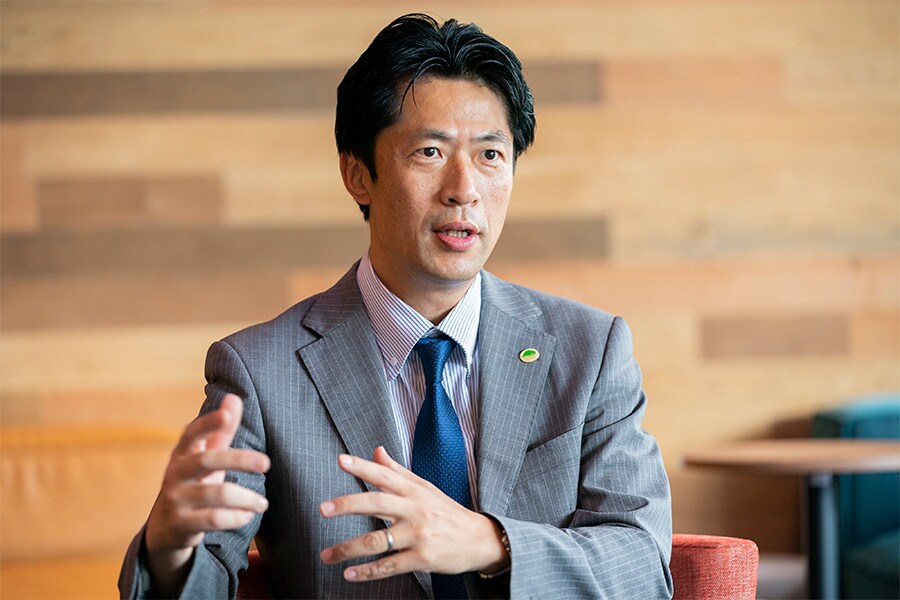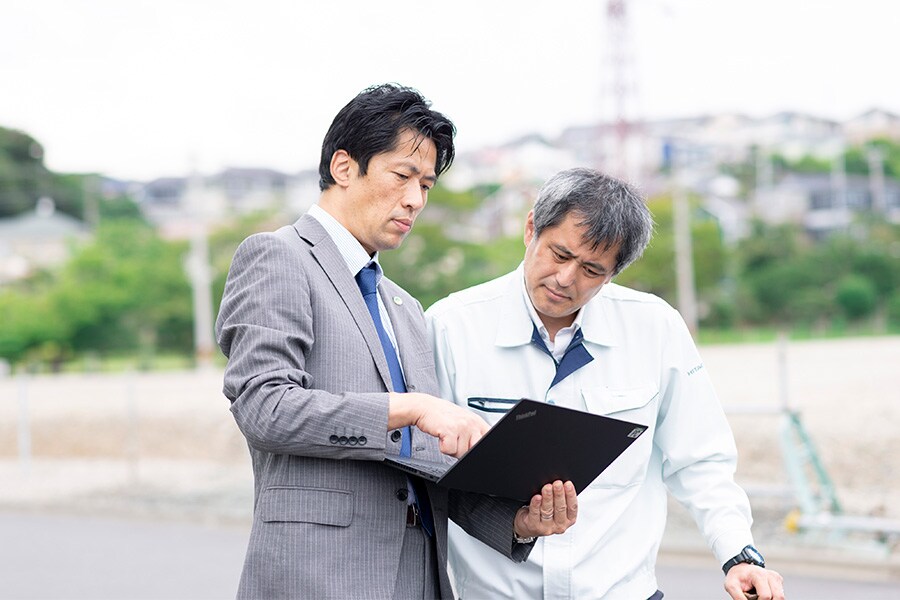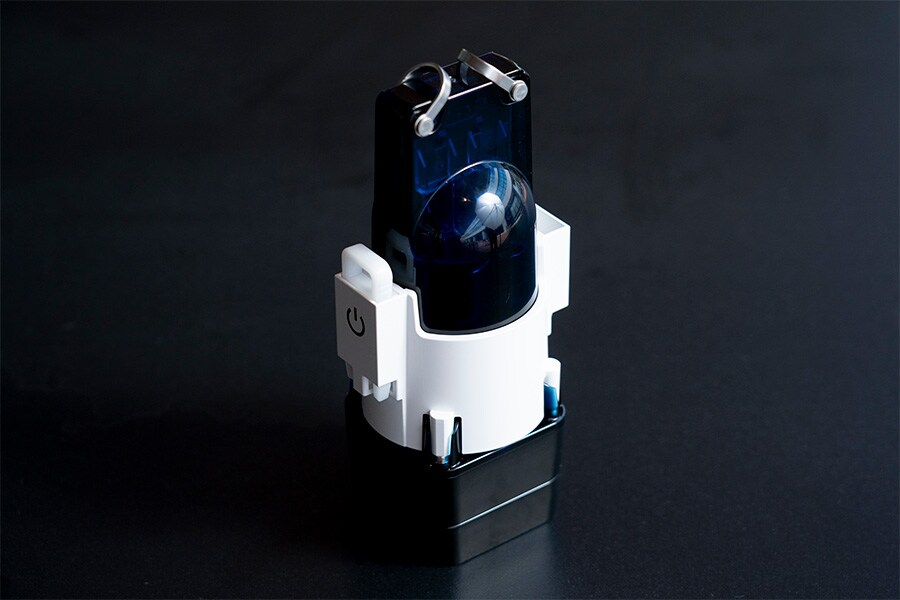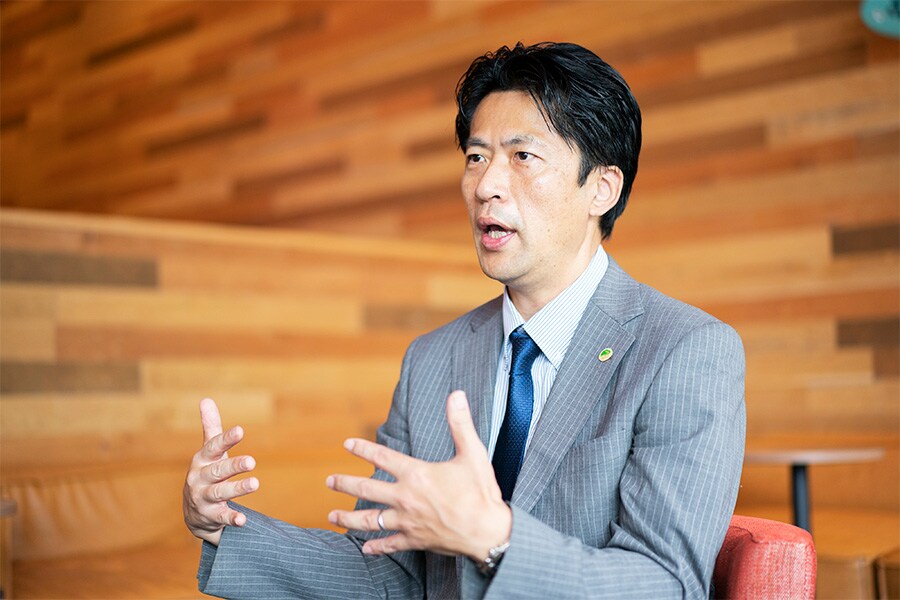Watch Video: The People of Hitachi – Saving Infrastructure with Water Leakage Detection Sensor
In recent years, floods have recently become more common and accidents such as sinkholes have formed due to corroded water pipes. It has been noted that water pipes produced in Japan during the period of record economic growth are now approaching the end of their service life. To decrease such incidents, it is vital to quickly detect water pipe leakage. However, the number of experienced engineers available is decreasing with the declining birthrate and aging population, making it difficult to timely identify locations where leaks are occurring.
In order to solve this problem, Hitachi has developed a proprietary ultra-sensitive vibration sensor (“water leakage detection sensor”). The sensor is installed on underground water pipes and detects vibrations unique to leaks, which enables locations with suspected leaks to be identified remotely. Masahiro Takeshima of Government & Public Corporation Information Systems Division at Hitachi, Ltd., who leads this development project, spoke about the behind-the-scenes of the creation of this sensor.
The first time Masahiro came to know about Hitachi was in elementary school when he visited a plant in Yamaguchi Prefecture that his friend’s father was working at. That plant was manufacturing trains for the Tohoku Shinkansen that had yet to be publicly unveiled. The green-colored trains sent his heart aflutter, and he fell in love with Hitachi, thinking “Hitachi is such a cool company!”
He researched semiconductors at university and experimented with blue-light-emitting diodes. He started working at Hitachi in 1993 and since then has been involved in launching new businesses. He has had a hand in many projects, including a security system for prisons that shows prisoner location and IT systems for wholesale markets.

Masahiro during the interview
Masahiro became involved in the development of the water leakage detection sensor in 2016, during an in-house training project to find hints for generating new business. The training course covered a topic about solving issues facing gas companies, waterworks departments, and other infrastructure service providers, but he did not have many experiences with infrastructure business. To understand more about this field, he visited almost 20 companies and local governments over the period of one month to talk to people on the front lines of infrastructure.
Masahiro says: “When talking to customers for the purpose of selling a certain product, one tends to say, ‘You need this kind of product,’ but I said to them, ‘Tell me whatever it is that you are struggling with.’ This enabled me to extract their true feelings.”

Masahiro spoke with many infrastructure service providers to discover new issues
One of the places that he visited was the Yokohama Waterworks Bureau. There, he learned that a pressing issue involved leaks from water pipes that are approaching the end of their service life.
“I was surprised to learn this, as I simply thought that you turn the faucet and water comes out, and I had never imagined about water pipes corroding and leaking, so I thought this is a dire situation that must be solved.”
Conventionally, engineers would use a tool called an “acoustic water leakage detector” to listen for vibrations in water pipes to determine whether there were any leaks in the pipes. However, this method requires that the operator has technical expertise to recognize the sound of a leak, and the number of engineers with such expertise has been declining over the years.
Masahiro says: “I went on-site and tried listening for leaks, but I had no idea which sound was the sound of a leak. Unless this implicit knowledge possessed by veteran engineers is passed on, we will no longer be able to find water leaks. Not only are customers struggling with this, but I also thought that it is a social issue that Hitachi should try to solve.”
There are water pipes buried in the ground all over Japan, and it is said that they would surround the Earth 14 times if laid down one after the other. These pipes are deteriorating, and the number of veteran engineers required to inspect them is also decreasing as time goes by. Masahiro, who saw this situation with his own eyes, decided to launch a new business that focuses on water leak detection.
The first method that Masahiro thought of to detect underground water leaks was to develop a sensitive sensor that can detect minute vibrations generated by leaks. It was at this time that Masahiro learned about a sensor for underground resources exploration that was being developed in a different project, so he thought about applying this sensor to detect vibrations from leaks.

Sensitive sensors: Installed on water pipes to detect vibrations from leaks
He created a prototype and contacted a number of waterworks departments to collaborate with proof-of-concept (PoC) testing, but this is where he hit a roadblock: no waterworks departments were interested in collaborating. As the product was not yet proven, they all told him that they wanted to see it once it was fully ready to go.
Masahiro says: “A number of companies had tried sensor leakage detection in the past, but getting the sensor to correctly detect leaks was difficult. This isn’t limited to only main drain pipes—detecting leaks in narrow supply pipes that run off drain pipes is also extremely difficult. Someone at a waterworks department told me: ‘Leakage detection is very complicated and not something that can be accomplished easily.’ However, my desire to tackle this challenge increased because it was hard.”

Test site at farmland in Ibaraki Prefecture, with water pipes created by the project team
That’s when Masahiro’s thinking changed. He thought that if waterworks departments would not collaborate with him, he would make his own test site. He and his team leased farmland in Ibaraki Prefecture and installed about 200 meters of pipes. They made damages to the pipes to generate artificial leaks and collected vibration data.
“The vibration data that we collected at the test site was only simulated data. But it was essential that we first prove that we could collect such data, and I thought that, by going to these lengths to collect data, we would be able to show customers that we were serious.”
While Masahiro and his team were collecting data at their self-made test site, a significant event occurred: Kumamoto experienced a large earthquake in April 2016 that cracked many water pipes.
There was a rapid increase in water-leakage-related problems immediately after the earthquake hit, and the Kumamoto City was busy dealing with this. When Masahiro learned about this, he wanted to use the sensor that they were improving to detect leaks and help the disaster area. Hence, he approached the Kumamoto City Waterworks and Sewerage Bureau to see if they would be interested in PoC testing.
Masahiro says: “I knew I had to do a real-world experiment. As we were going to use a product that was not yet commercialized, the bureau held a board of review, at which we got approval to do PoC testing.”
Finally, PoC testing began in the business district and residential areas of Kumamoto City in March 2018 with multiple sensors being installed on water pipes. However, they did not get the results that they were expecting. This was because the sensors mistakenly detected vibrations from septic tanks, water used by hotels, trains, people walking, and all manners of other vibrations found in an urban setting.
Unlike the test site at the farmland in Ibaraki, the amount of urban noise was more than they expected. The reason why detecting water leaks with a sensor had long been difficult was because of the difficulty in differentiating between leaks and other vibrations.
“It was shocking. The city was bathed in noise, and the challenge was how to improve sensor accuracy. But I never thought about quitting. Even if we did give up in the end, I wanted to thoroughly look at every angle first.”

Masahiro during the interview
Masahiro and his team walked all over the city and collected samples of various vibrations. When they got information about a leak, they immediately rushed to the site and collected data on the vibrations from the leak. They then compared the vibrations from a leak and the vibrations from other sources to clarify the differences.
As a result of analyzing over 10,000 vibration datasets, they successfully identified the characteristics of vibrations caused by water leaks. They discovered that vibrations from water leaks are continuous, whereas other vibrations, such as from trains, construction, and people walking, have discontinuous waveforms.
“Although it was extremely difficult to improve accuracy, I strongly felt that false positives must be reduced to as close to zero as possible for Hitachi to commercialize the device. We firstly isolated the confusing noise and then analyzed the differences with vibrations from water leaks to improve the algorithm.”
Masahiro continued to increase the accuracy of the sensor based on the collected data. The PoC testing they performed in Kumamoto City discovered a 14 new leaks. The testing proved that the sensor could identify leaks with high probability and no false positives.
As others were impressed by these results, Masahiro’s water leakage detection sensor has gradually gained attention throughout Japan, starting with PoC testing that began in Fukuoka City in October 2021.
Masahiro concluded by saying: “If one changes one’s thinking of a problem that was previously thought to be unsolvable, a solution to the problem presents itself. After being involved in this project, I strongly believe that, if there is no precedent, then you should create one yourself. I hope that the water leakage detection sensor proliferates not only throughout Japan, but across the world in the future.”